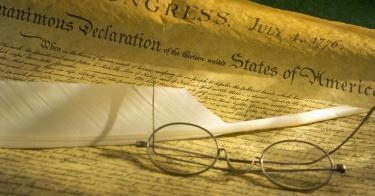Since 1884, members of Congress taking office swear to “support and defend the Constitution of the United States.” The Constitution, explained the Supreme Court in 1795, “contains the permanent will of the people...and can be revoked or altered only by the authority that made it.” The Constitution’s first words identifies that authority: “We the People.” Today, however, members of Congress want to ignore what America’s founders considered the heart of the system of government they established: the separation of powers.
“No political truth,” wrote James Madison in The Federalist No. 47, “is certainly of greater intrinsic value, or is stamped with the authority of more enlightened patrons of liberty.” Alexander Hamilton agreed in The Federalist No. 78, quoting the philosopher Montesquieu that there is “no liberty” without the separation of powers. Thomas Jefferson echoed the point, writing that “concentrating these [powers] in the same hands is precisely the definition of despotic government.” If the Founders were right, swearing to support and defend the Constitution should mean, at the very least, an irrevocable commitment to preserving the separation of powers.
And yet, as the Associated Press reported, leading House Democrats met with President Joe Biden last month and urged him to “go it alone” by using executive actions to accomplish legislative objectives they have been unable to achieve. On issues from voting rights and immigration to so-called police reform, the Democrats’ legislative agenda has collapsed and, with the mid-term election looming, they want Biden to “push their proposals forward without votes in the House and Senate.”
Imagine that: legislators wanting to hang onto power by having the president do their legislating for them.
>>> Finding the Constitution’s Common Good
In Morrison v. Olson, one of the most important cases involving the separation of powers, the Supreme Court in 1988 upheld the Independent Counsel Act, even though it allowed appointment of an executive branch official that the president, the head of the executive branch, could not remove. Dissenting, Justice Antonin Scalia wrote that the case was about one thing: “Power... Frequently an issue of this sort will come before the Court clad, so to speak, in sheep’s clothing... But this wolf comes as a wolf.” So do the current calls for the president to impose by executive action a policy agenda that Congress alone has authority to establish by legislation.
Power tends to corrupt, Lord Acton said, and this is not the first time that it has led to such collusion between the legislative and executive branches to avoid limits on their power. In 2007, when he was running for president, Barack Obama vowed to roll back what he claimed had been executive power run amok during the George W. Bush administration. After taking office, however, Obama said: “We’re not going to be waiting for legislation... I’ve got a pen and I’ve got a phone... and I can use that pen to sign executive orders and take executive actions.”
That’s exactly what he tried to do. Republicans picked up more than 60 House seats, and the majority, in the 2010 election. Four years later, a few weeks after Republicans also captured the Senate, Obama announced a series of executive actions to change immigration policy, effectively changing the legal status of millions of illegal aliens to avoid deportation. Congress had not done it, so the president would.
That is, in fact, the motivation behind such a powerplay: the ends justify the means and the branches, rather than being separate, are actually interchangeable. Perhaps Congress should be given the first crack but, in the end, the objective is to get the job done. The issue, however, is not the order in which the branches act, but which branch has authority to act at all. The issue is not that it’s good form to let Congress go first, the issue is that Congress alone has authority to go at all. The courts had to step in and stop this attempt to legislate by executive action.
>>> Jobs, Family, Loyalty: Identifying the Governing Vision of National Conservatives
The Washington Post at the time described Obama’s action as a “unilateral decision to legalize the presence of nearly 4 million undocumented immigrants.” If anything represents the opposite of the Founders’ separation of powers principles, it is phrases such as “unilateral decision” and “go it alone.” That impulse instead represents, as Madison wrote, “the accumulation of all powers… in the same hands… [which] may justly be pronounced the very definition of tyranny.”
America’s founders did not discuss ideas like these in the abstract. They fought a revolution and established an actual system of government based on these principles in order to maximize liberty. The limitation, by separation and other means, of government power remains the heart of that system.
In his farewell address in 1796, President George Washington affirmed the “necessity of reciprocal checks in the exercise of political power” and warned: “To preserve them must be as necessary as to institute them.” The only way to do that is for members of Congress to take their oath seriously and put liberty ahead of power.
This piece originally appeared in Christian Renewal




